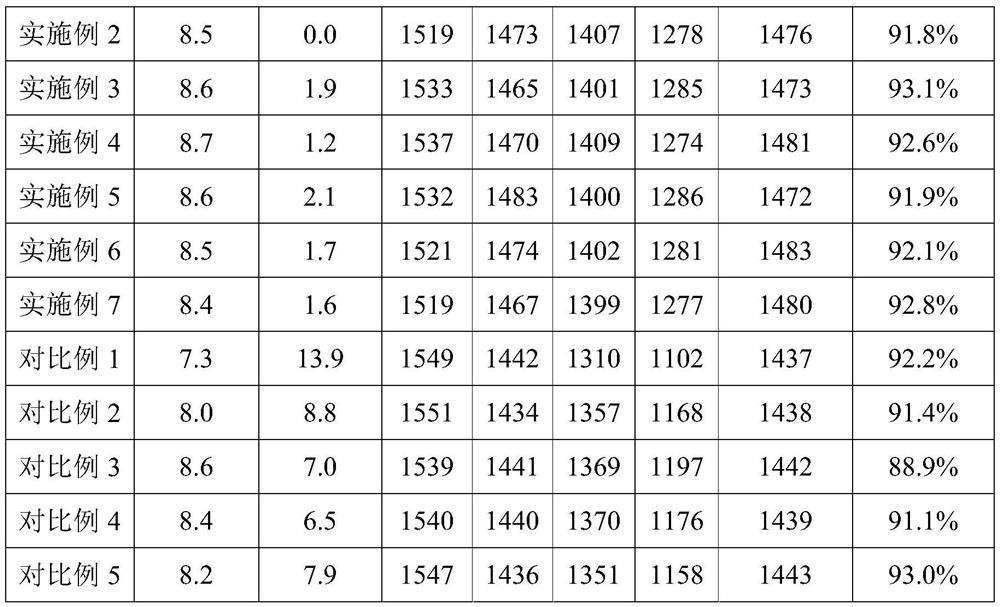A kind of non-aqueous electrolyte and preparation method thereof and application in lithium ion battery
A non-aqueous electrolyte and lithium salt technology, which is applied in the field of lithium-ion batteries, can solve problems that need to be further improved, and achieve excellent fast charging performance and cycle performance, good lithium-conducting performance, and good film-forming effects
- Summary
- Abstract
- Description
- Claims
- Application Information
AI Technical Summary
Problems solved by technology
Method used
Image
Examples
Embodiment 1
[0044] A non-aqueous electrolyte comprising lithium salts, organic solvents and additives,
[0045] The organic solvent includes: 20% diethyl carbonate DEC, 20% ethyl methyl carbonate EMC, 20% ethylene carbonate EC, 10% trimethylsilyl substituted propylene carbonate TMSPC and 30% tetrafluoroethylene Base-tetrafluoropropyl ether HFE;
[0046] Lithium hexafluorophosphate whose lithium salt is 2mol / L;
[0047] Based on the total mass of the electrolyte as 100%, the additives include 1.0% lithium difluorophosphate LiPO 2 f 2 , 1.0% vinyl sulfate DTD, 3.0% tris(2,2,2-trifluoroethyl)phosphate TFEP.
[0048] The preparation steps of non-aqueous electrolyte are as follows:
[0049] S1. Dewatering of raw materials: In an anhydrous and oxygen-free glove box, use a 4A (5A) water separation sieve to dewater the solvent, diluent, and additives. The treatment time is 20 to 30 hours, and the water content is less than 10ppm. Solvents, thinners and additives;
[0050] S2. Preparation of...
Embodiment 2
[0055] A non-aqueous electrolyte comprising lithium salts, organic solvents and additives,
[0056] The organic solvent includes: 25% diethyl carbonate DEC, 25% ethyl methyl carbonate EMC, 20% ethylene carbonate EC, 10% trimethylsilyl substituted butylene carbonate TMSBC and 20% tetrafluoroethylene Ethyl-tetrafluoropropyl ether HFE;
[0057] Lithium hexafluorophosphate whose lithium salt is 2mol / L;
[0058] Based on the total mass of the electrolyte as 100%, the additives include 1.0% lithium difluorophosphate LiPO 2 f 2 , 1.0% vinyl sulfate DTD, 3.0% tris(2,2,2-trifluoroethyl)phosphate TFEP.
[0059] The preparation steps of the non-aqueous electrolyte are as in Example 1.
[0060] Battery assembly and testing:
[0061] Inject the above electrolyte into the dried 2000mAh LiNi 0.8 co 0.1 mn 0.1 o 2 / Graphite soft-packed batteries, the batteries are routinely divided after being placed at 45°C, formed by high-temperature fixtures and sealed twice.
[0062] Then the b...
Embodiment 3
[0064] A non-aqueous electrolyte comprising lithium salts, organic solvents and additives,
[0065] The organic solvent includes: 25% diethyl carbonate DEC, 25% ethyl methyl carbonate EMC, 20% ethylene carbonate EC, 10% trimethylsilyl substituted propylene carbonate TMSPC and 20% tetrafluoroethylene Base-tetrafluoropropyl ether HFE;
[0066] Lithium hexafluorophosphate whose lithium salt is 2mol / L;
[0067] Based on the total mass of the electrolyte as 100%, the additives include 1.0% lithium difluorophosphate LiPO 2 f 2 , 1.0% vinyl sulfate DTD, 3.0% tris(2,2,2-trifluoroethyl)phosphate TFEP.
[0068] The preparation steps of the non-aqueous electrolyte are as in Example 1.
[0069] Battery assembly and testing:
[0070] Inject the above electrolyte into the dried 2000mAh LiNi 0.8 co 0.1 mn 0.1 o 2 / Graphite soft-packed batteries, the batteries are routinely divided after being placed at 45°C, formed by high-temperature fixtures and sealed twice.
[0071] Then the b...
PUM
| Property | Measurement | Unit |
|---|---|---|
| diameter | aaaaa | aaaaa |
Abstract
Description
Claims
Application Information
 Login to View More
Login to View More - R&D
- Intellectual Property
- Life Sciences
- Materials
- Tech Scout
- Unparalleled Data Quality
- Higher Quality Content
- 60% Fewer Hallucinations
Browse by: Latest US Patents, China's latest patents, Technical Efficacy Thesaurus, Application Domain, Technology Topic, Popular Technical Reports.
© 2025 PatSnap. All rights reserved.Legal|Privacy policy|Modern Slavery Act Transparency Statement|Sitemap|About US| Contact US: help@patsnap.com


